Explanation of my 10 Ballon d'Or 1977
This is my ranking, my opinion on the Ballon d'Or of the year 1977. This ranking is based on the calendar year, not the season. What counts for this ranking is the player's regularity over the calendar year, the number of matches played, the ability to raise his level in big games, statistics (goals, assists, clean sheets, goals conceded, etc.) and trophies won (collective and individual).
#10 Johan Cruyff
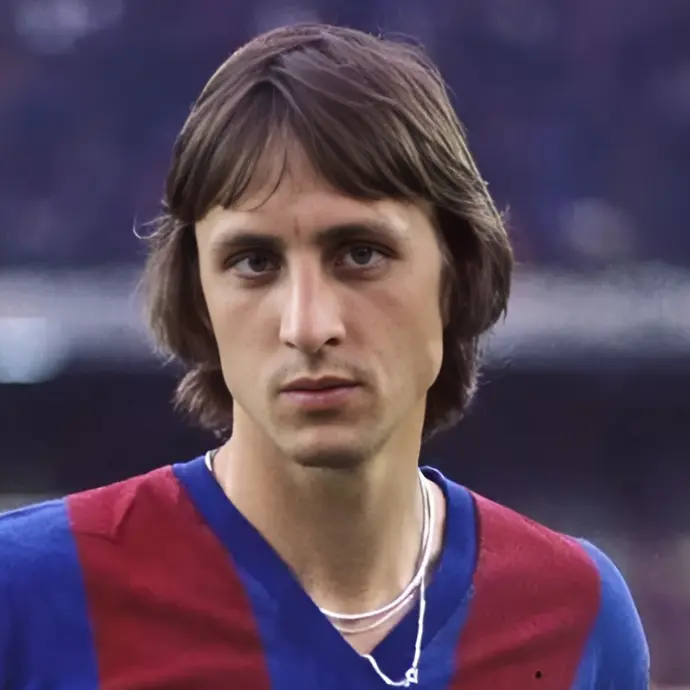
- Age : 29/30 years old
- Club : FC Barcelona
- Statistics : 37 games, 16 goals, / assists
- Trophies : Liga Vice-Champion
- Individual Awards :
Liga POTY, Liga TOTY
In 1977, Johan Cruyff was still the game’s philosopher-king, a visionary in boots who played football like it was chess at full speed. At 30, he was no longer the boy wonder of Ajax or the golden thread of the 1974 Dutch team, but he remained the soul of FC Barcelona and the embodiment of Total Football. That year, Cruyff dazzled with his mind as much as his feet—dropping deep, orchestrating attacks, and bending matches to his will with a flick, a feint, or a 40-yard pass that split defenses like a scalpel. But 1977 was also the year the myth began to fracture. Off the pitch, Cruyff’s life took a dark turn. In September, he and his family were the victims of a terrifying home invasion in Barcelona—a failed kidnapping that left psychological scars deeper than any tackle ever could. The ordeal shook him. For a man who had always played with freedom, the idea of being trapped—physically, emotionally—was unbearable. He began to retreat from the spotlight, to protect what mattered most. That year, he still lit up stadiums. In April, he scored against PSG in a friendly at the Parc des Princes, a reminder that even in a quieter phase, his genius could still roar. But the fire was dimming. He was no longer chasing trophies—he was chasing peace.
#9 Michel Platini
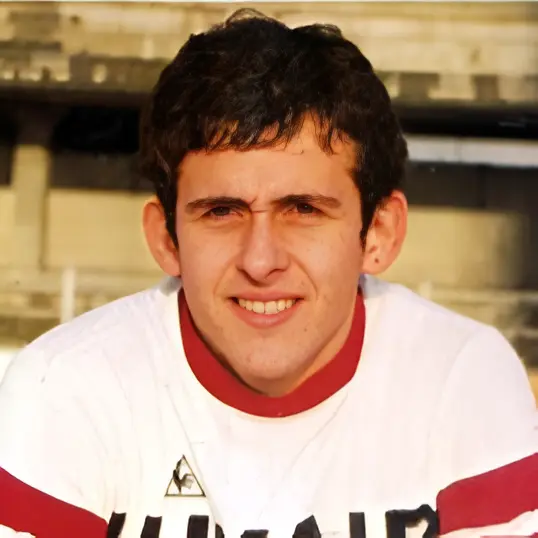
- Age : 21/22 years old
- Club : AS Nancy-Lorraine
- Statistics : 48 games, 21 goals, / assists
- Trophies : /
- Individual Awards : French POTY, French League POTY, French League TOTY
In 1977, Johan Cruyff was still the game’s philosopher-king, a visionary in boots who played football like it was chess at full speed. At 30, he was no longer the boy wonder of Ajax or the golden thread of the 1974 Dutch team, but he remained the soul of FC Barcelona and the embodiment of Total Football. That year, Cruyff dazzled with his mind as much as his feet—dropping deep, orchestrating attacks, and bending matches to his will with a flick, a feint, or a 40-yard pass that split defenses like a scalpel. But 1977 was also the year the myth began to fracture. Off the pitch, Cruyff’s life took a dark turn. In September, he and his family were the victims of a terrifying home invasion in Barcelona—a failed kidnapping that left psychological scars deeper than any tackle ever could. The ordeal shook him. For a man who had always played with freedom, the idea of being trapped—physically, emotionally—was unbearable. He began to retreat from the spotlight, to protect what mattered most. That year, he still lit up stadiums. In April, he scored against PSG in a friendly at the Parc des Princes, a reminder that even in a quieter phase, his genius could still roar. But the fire was dimming. He was no longer chasing trophies—he was chasing peace.
#8 Rob Rensenbrink
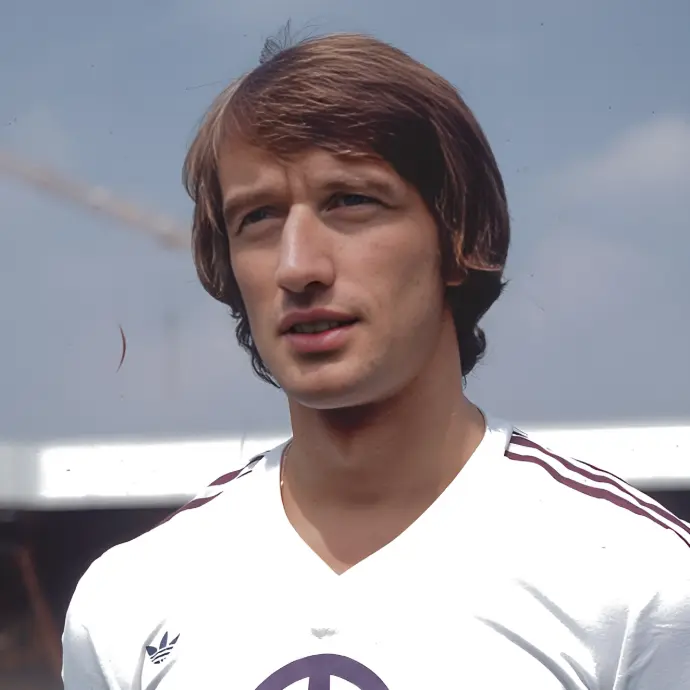
- Age : 29/30 years old
- Club : Anderlecht
- Statistics : 44 games, 21 goals, / assists
- Trophies : Finalist Cup Winners Cup, Belgian League Vice-Champion, Finalist Belgian Cup
- Individual Awards : Cup Winners Cup TOTY, Belgian League TOTY
In 1977, Rob Rensenbrink was Europe’s most elegant assassin—an artist in exile from the spotlight, weaving magic from the left wing in Anderlecht purple. While Johan Cruyff commanded headlines in Spain and Platini rose in France, Rensenbrink ruled quietly from Brussels. He wasn’t just a winger—he was a contortionist with a ball at his feet, nicknamed The Snake Man for the way he slithered past defenders with impossible grace. That year, he led Anderlecht to their second European Cup Winners’ Cup title in three years. He scored 5 goals in 6 matches in the competition, including a dazzling brace in the final against Austria Vienna—a 4–0 demolition at the Parc des Princes. He didn’t just lift the trophy. He owned the night. In all competitions, Rensenbrink netted over 21 goals in 1977 and is estimated to have delivered 15 to 20 assists—though no one was counting back then. He was both creator and finisher, a player who didn’t need to sprint because the game bent to his rhythm. Every touch was a feint. Every movement, a riddle.
#7 Teófilo Cubillas
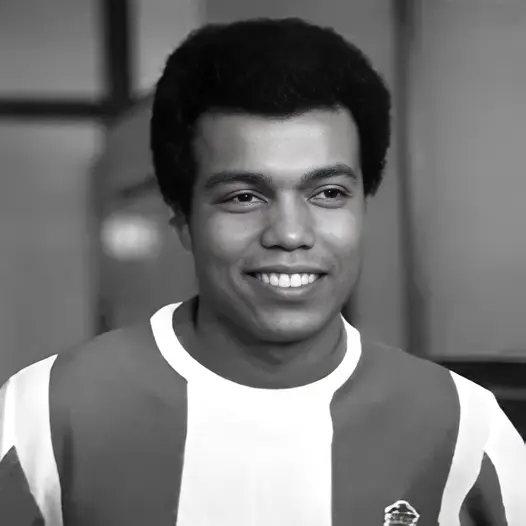
- Age : 27/28 years old
- Club : FC Porto/Alianza Lima
- Statistics : 37 games, 25 goals, / assists
- Trophies : Peruvian League
- Individual Awards : Peruvian League POTY, Peruvian League TOTY
In 1977, Teófilo Cubillas came home—not as a prodigal son, but as a conquering hero. After dazzling Europe with FC Porto, where he scored 65 goals in 108 matches, “El Nene” returned to Alianza Lima with the grace of a maestro and the hunger of a street footballer. He wasn’t just back in Peru—he was back to remind the continent what genius looked like in motion. That year, Cubillas was unstoppable. He scored 23 goals in 32 league matches for Alianza Lima, leading the club to the Peruvian championship and reclaiming his throne as the nation’s footballing icon. But it wasn’t just the goals—it was the way he scored them. Outside-of-the-foot curlers, free kicks that bent physics, and slaloming runs that left defenders hypnotized. He played like he was composing symphonies with his right foot. And he wasn’t done. In 1977, he also helped Peru qualify for the 1978 World Cup, scoring twice in a 5–0 demolition of Bolivia in the qualifiers. At 28, he was no longer the teenage prodigy of Mexico ’70—he was a complete player, a leader, a legend in full bloom.
#6 Klaus Fischer
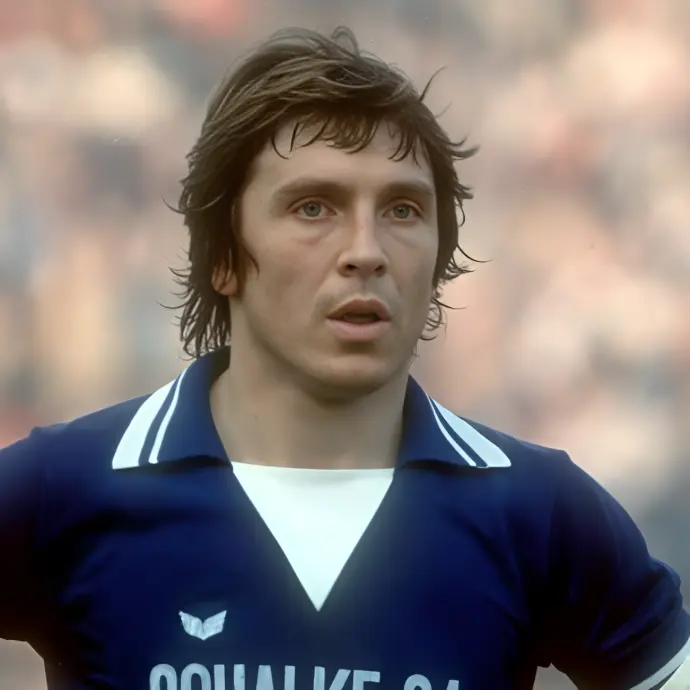
- Age : 27 years old
- Club : Schalke 04
- Statistics : 54 games, 43 goals, 2 assists
- Trophies : Bundesliga Vice-Champion
- Individual Awards : Bundesliga TOTY, Bundesliga Golden Shoe (29 goals)
In 1977, Klaus Fischer wasn’t just scoring goals—he was redefining how they could be scored. At Schalke 04, he was the Bundesliga’s silent executioner, a striker who didn’t just finish chances—he finished them with flair. That year, Fischer netted 24 goals in the Bundesliga, helping Schalke to a second-place finish behind Borussia Mönchengladbach2. But it wasn’t the number that stunned—it was the style. On November 16, 1977, in a friendly against Switzerland, Fischer etched his name into football folklore. With his back to goal, he launched into a perfect bicycle kick—midair, horizontal, and impossibly precise. The ball rocketed into the net. It wasn’t just the Goal of the Year. It was later voted Goal of the Decade. Then Goal of the Century. That moment didn’t just define Fischer—it defined a generation of German football. But 1977 was more than a highlight reel. It was the year he debuted for West Germany at age 27, scoring prolifically: 7 goals in 6 World Cup qualifiers, and 17 goals in 23 friendlies between 1977 and 1982. Late to the national team, perhaps—but he arrived like thunder. Fischer wasn’t flashy off the pitch. He didn’t need to be. His goals spoke in exclamation points. He was a master of the spectacular made routine, a striker who turned instinct into art.
#5 Roberto Bettega
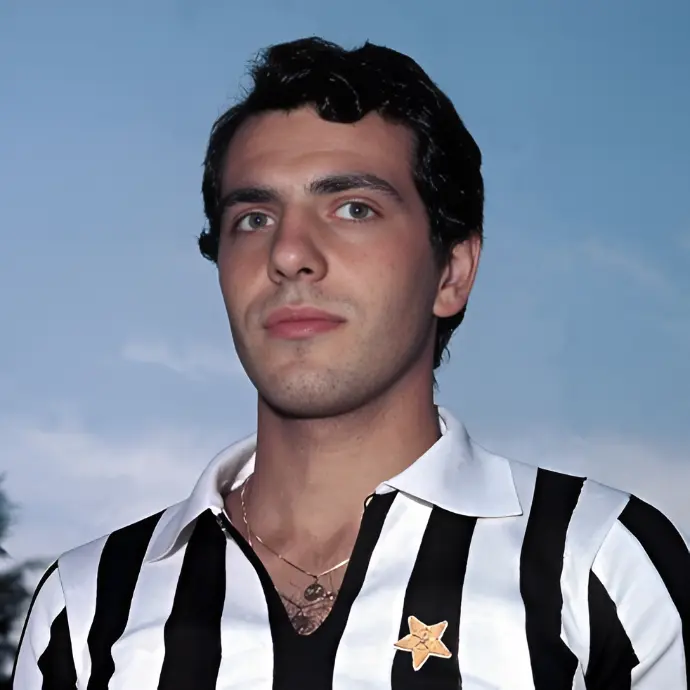
- Age : 26 years old
- Club : Juventus Turin
- Statistics : 50 games, 25 goals, / assists
- Trophies : Europa League, Serie A
- Individual Awards :
Europa League TOTY, Serie A TOTY
In 1977, Roberto Bettega wasn’t just Juventus’s talisman—he was Italian football’s elegant assassin, a forward who blended grace with grit, poetry with power. At 26, Bettega was at the peak of his powers, leading a Juventus side that was both ruthless and refined. That year, he scored 25 goals across all competitions, as the Bianconeri stormed to the Scudetto and lifted their first-ever European trophy—the UEFA Cup. But Bettega wasn’t just about numbers. He was about moments. Towering headers that seemed to defy gravity. Backheel flicks that left defenders frozen. A presence that made the ball look like it belonged at his feet. Nicknamed “Penna Bianca” for his prematurely silver hair, he played with the wisdom of a veteran and the hunger of a street footballer. His goal in the UEFA Cup final against Athletic Bilbao—an arcing header in the cauldron of San Mamés—wasn’t just decisive. It was iconic. And yet, for all his brilliance, Bettega often stood in the shadow of more flamboyant stars. He wasn’t loud. He didn’t need to be. His football spoke in sonnets. That season, under the emerging genius of Giovanni Trapattoni, Bettega became the beating heart of a Juventus revolution. Every match he played felt like a masterclass in timing, positioning, and quiet devastation.
#4 Gerd Müller
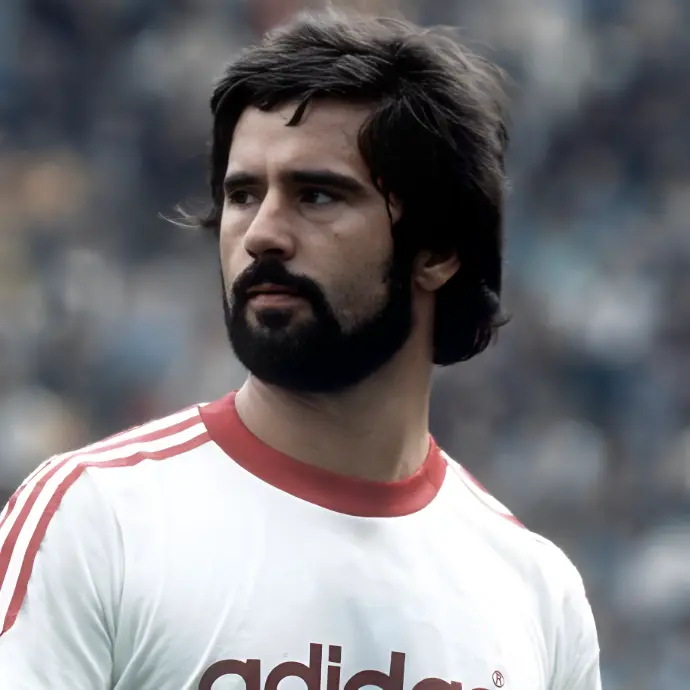
- Age : 31/32 years old
- Club : Bayern Munich
- Statistics : 36 games, 38 goals, 5 assists
- Trophies : /
- Individual Awards : Champions League TOTY, Champions League Golden Shoe (5 goals)
In 1977, Gerd Müller was no longer the fresh-faced phenom who had terrorized defenses in the early '70s—he was something more dangerous: a master who knew every inch of the penalty box like a hunter knows his terrain. At 31, “Der Bomber” was still detonating in the Bundesliga, scoring 28 goals in 25 league matches for Bayern Munich that season. He wasn’t just scoring—he was doing it with ruthless efficiency, like a man who had turned finishing into a science. That year, Müller added another 5 goals in European competition, and even as Bayern’s golden era began to fade, his instincts never dulled. He didn’t need space. He didn’t need time. He needed half a second, half a yard, and the ball was in the net. Headers, volleys, toe pokes—he scored them all with the same cold precision. He wasn’t flashy. He was inevitable.
#3 Allan Simonsen
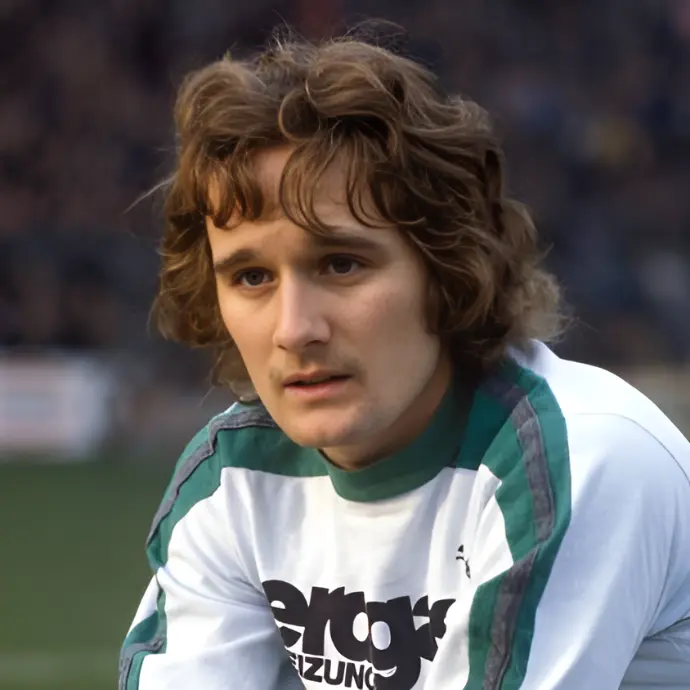
- Age : 24/25 years old
- Club : Borussia M'gladbach
- Statistics : 52 games, 30 goals, / assists
- Trophies : Finalist Champions League, Finalist Intercontinental Cup, Bundesliga
- Individual Awards : Champions League TOTY, Bundesliga TOTY
In 1977, Allan Simonsen stood just 1.65 meters tall—but he played like a giant. With Borussia Mönchengladbach, Simonsen was the heartbeat of a team that danced through the Bundesliga and stormed into the European Cup final. He wasn’t just fast—he was untouchable. A blur of dribbles, feints, and sudden bursts of genius. That season, he scored in every major European final he played. In May 1977, he struck a thunderous goal against Liverpool in the European Cup final in Rome—a lone spark in a 3–1 defeat, but a moment that lit up the continent. He finished the year with 30 goals in 52 matches, and countless assists that don’t show up in the record books but live on in the memories of those who watched him. Simonsen wasn’t just a winger. He was a creator, a finisher, a conductor. After Günter Netzer and Henning Jensen left Gladbach, it was Simonsen who stepped into the void—not with noise, but with elegance. He led the club to a third straight Bundesliga title in 1977, and his performances in Europe made him a cult hero beyond Germany. And yet, he came from a country that hadn’t even qualified for a major tournament in over a decade. Denmark wasn’t on the football map. But Simonsen was. He made sure of it. That Ballon d’Or wasn’t just a personal triumph—it was a statement. That greatness can come from anywhere. That size doesn’t matter when your game is this big.
#2 Zico
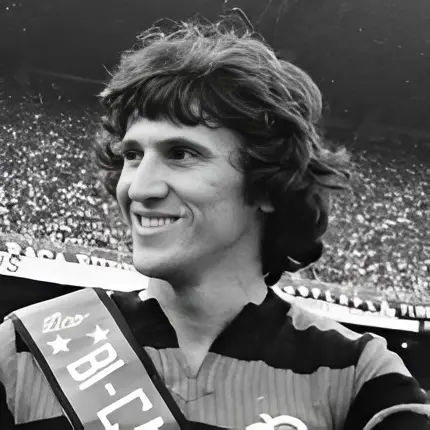
- Age : 23/24 years old
- Club : Flamengo
- Statistics : 49 games, 42 goals, 19 assists
- Trophies : /
- Individual Awards : South American POTY, Rio Championship POTY, Rio Championship TOTY, Rio Championship Golden Shoe (27 goals)
In 1977, Zico wasn’t just Brazil’s best player—he was its heartbeat. At Flamengo, he was the conductor of a samba symphony, a No. 10 who played with the precision of a surgeon and the soul of a poet. That year, he scored 42 goals in 49 matches across all competitions, dominating the Campeonato Carioca and Série A with a blend of elegance and fury. He didn’t just play football—he elevated it. Zico’s right foot was a wand. Free kicks bent like whispers into the top corner. One-touch passes sliced through defenses like sunlight through shutters. He wasn’t the fastest, but he was always first to the idea. In 1977, he was named South American Footballer of the Year, the first of three times he would win the honor. And he did it all while playing in Brazil, far from the European spotlight. For the Seleção, he was just as devastating. In World Cup qualifiers and friendlies that year, he scored 7 goals in 8 appearances, including a brace against Colombia and a thunderbolt against Paraguay. He was no longer the prodigy of 1974—he was the leader of a golden generation in the making. But Zico didn’t chase fame. He chased perfection. Every match in 1977 felt like a masterclass in control, vision, and execution. He wasn’t just the “White Pelé” because of his talent—he was called that because he made the impossible feel routine. In 1977, Zico didn’t just rise—he ruled. And in doing so, he reminded the world that the beautiful game still lived in Rio, draped in red and black, and danced to the rhythm of his right foot.
Winner : Kevin Keegan
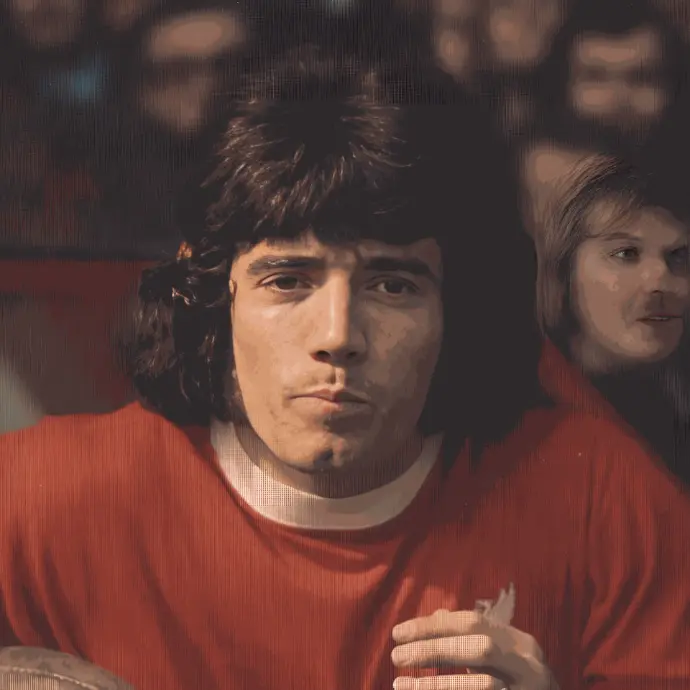
- Age : 25/26 years old
- Club : Liverpool FC/Hamburg SV
- Statistics : 65 games, 23 goals, 12 assists
- Trophies : Champions League, Finalist UEFA Supercup, Premier League, Finalist English Cup
- Individual Awards : Champions League TOTY, Premier League TOTY
In 1977, Kevin Keegan was England’s most electrifying export—a relentless force of will wrapped in a No. 7 shirt. That year, he stood at the crossroads of two footballing worlds: the end of a glorious era at Liverpool and the beginning of a bold new chapter in Germany. But before he left Anfield, he gave the Kop one final masterpiece. Keegan’s 1976–77 season was a crescendo. During that year, he scored 23 goals in all competitions, led Liverpool to a league title, and played a starring role in their first-ever European Cup triumph. In the final against Borussia Mönchengladbach, he tormented Berti Vogts all night, eventually winning the penalty that sealed a 3–1 victory. It was the perfect farewell. He left the pitch in Rome with a medal around his neck and a black eye on his face—a warrior’s exit. But 1977 wasn’t just about glory. It was about guts. That summer, Keegan shocked England by announcing his move to Hamburger SV. The German press was skeptical. The fans were curious. And Keegan? He was determined. He arrived in Hamburg with a suitcase, a translator, and a point to prove. The adjustment was brutal—new language, new tactics, new expectations. But Keegan never hid. He ran harder. Fought harder. For England, he remained the talisman. In November 1977, he scored a towering header against Italy in a World Cup qualifier at Wembley, beating Dino Zoff to the ball like a man possessed. It wasn’t enough to send England to Argentina, but it was enough to remind the world: Keegan never stopped running.